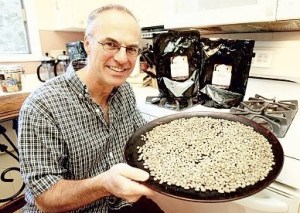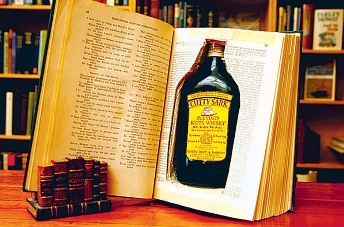One of the most interesting things I’ve gotten to do at the Journal is to fly on a mission with STARS air ambulance. As usual, I wrote and wrote and wrote and my editors cut and cut (don’t get me wrong, I’m still happy). Here is the story that was in yesterday’s papers (and another one which was the main feature). Also check out photos from the flight in my Flickr feed on the right, several of which ended up in the paper.
This is the uncut and unedited story (not the one I submitted, but close to it).
***
If I learned just one lesson from STARS air ambulance mission #19,937, it’s this: adrenalin is overrated.
It’s 2 p.m. on a bright Saturday afternoon and I’m standing in a blue jumpsuit on the tarmac at the Edmonton City Centre Airport. The iconic red STARS 3 helicopter is in front of me, its crew on standby for another mission.
I’ve been given permission to tag along, wherever they go, however white-knuckled the destination.
The sun is already heading westward, but we’re stuck.
Nurse Deb Bowers holds an iPhone and looks ahead while listening to a consult between emergency doctor Mark MacKenzie and Camrose hospital. The option of ground ambulance is weighed, or it may not be as serious as first thought. Or it could be too late. Pilots Alan Baldwin and J. N. Armstrong sit and stand nearby, white helmets ready at their side. I ask advanced life support paramedic Mike Gradidge how long an alert typically lasts.
“Sometimes 20 to 30 minutes,” says Gradidge. “But 5 to 10 minutes, usually.”
In usual time, Bowers announces the verdict: stand down.
“It’s like fishing,” Gradidge says as we walk back to the hanger. “That was the nibble you get before the bite.”
The fact that not every STARS mission is a highway collision, although those happen, is neatly illustrated that day. Inside the hangar, it’s all drama. STARS missions survivors — dubbed Very Important Patients — tell harrowing tales of rescue. Edmonton-Meadowlark MLA Raj Sherman, a former emergency physician who put in time with STARS, aptly sums up the critical minutes after a traumatic incident. He calls it “the golden hour of health care.“
An additional helicopter is here from Calgary to ferry media and survivors through Edmonton’s skies. On landing from a seven-minute whirl past the University and Commonwealth Stadium, I learn the crew had just repeated their earlier ritual: pre-alert, dressed and ready to go, but stood down. Another nibble.
An hour later, we finally get a bite: we’re dispatched to Two Hills to pick up an elderly female patient, struck by an autoimmune disease and in need of blood. It’s not Sherman’s golden hour, but the minutes are still precious.
***
3:57 p.m. Inside the STARS 3 helicopter.
I’m behind pilot Alan Baldwin, sitting in what would be the passenger side in a car. Paramedic Gradidge is just past a ventilator on my right, back-to-back with co-pilot J. N. Armstrong. Gradidge and I both face nurse Bowers, who is scribbling down case notes at the back of the helicopter.
It’s an experienced crew. This is Bower’s main gig — she puts in three shifts a week — rounding out her schedule instructing 4th-year nursing students at the University of Alberta. Gradidge is a part-timer, taking four or five shifts each month in addition to a full-time managerial role with Alberta Health Services.
Like most pilots, Baldwin is full-time, though his co-pilot is actually having some fun moonlighting. When not flying, Armstrong is the head anasthesiologist for the Calgary health region. In a pinch, as has happened 15 to 20 times, he can help thread a breathing tube through a windpipe.
4:07 p.m. Lift off.
The helicopter quivers as we rise. The crew assures me, “it’s normal.”
Our first stop is two kilometres down the road at the Royal Alexandra Hospital to pick up two units of blood for the mission. It’s one of the unsung duties of STARS missions, delivering blood products or essential equipment wherever needed. Approximately every fifth mission, a physician with mission-specific training rides along.
4:17 p.m. Back in the air.
Ten minutes pass while hospital security couriers two units of blood to the hospital roof.
“We were too quick,” says Mike Gradidge. It’s less a slow response by the hospital as it is a speedy flight. Pit stops typically last only a minute or two.
A fluorescent green “handle with care” sticker marks the nondescript white cardboard box: our precious cargo. Bowers places it on the stretcher.
Up in the air, Gradidge and Bowers slip into casual banter, joking about the trials of working together and the joys of raising teens. They’ve been through a lot together in 14 years. Bowers recalls the night when Gradidge was in my seat, his first mission a “rough” self-inflicted gunshot wound.
Gradidge has flown 393 missions since, while Bowers is on her 630th flight.
We pass over Elk Island National Park, where a few trees are still holding onto yellow leaves. Near the end of the flight, Baldwin spots a white cloud and tells us to look south. On closer view, it’s thousands of snow geese heading south for the winter.
4:48 p.m. Land at Two Hills.
Cutbacks in recent years mean Two Hills no longer maintains a hospital airstrip. The field is still pressed into service in extreme cases, but we’re assigned to a nearby airstrip where bails of hay appear to grow as we make our approach.
As the ambulance shuttles us to the hospital, Gradidge and Bowers tell me why they love their job. They tell me that in the early days, STARS paramedics and nurses were volunteers. When they began, workers received an honorarium of about $50 per shift, meaning the STARS crews were initial people who wanted to be there. The wait list to work at STARS has grown with the wages, but the crew is mostly comprised of veterans like Gradidge and Bowers, who have been there for over a decade.
Gradidge says the reasons to fly with STARS are obvious.
“It’s about an experience most people would die to get,” Gradidge says.
Bowers adds that while some of the calls are tragic, it’s amazing to just be there in a supportive role.
“I find it humbling,” Bowers says. “Sometimes it’s closure, just knowing everything was done.”
5:02 p.m. In the patient’s room.
At the hospital, Bowers is quick to talk to the patient, who is conscious, weak, and appreciative.
“Hi, I’m Deb, how are you, sweetie?”
While Gradidge takes the patient’s blood pressure, Bowers swiftly slips a blood sample from her IV and plugs it into a handheld blood metre. Hemoglobin, glucose, and other readings appear on a screen in less than 120 seconds. A staff nurse records the particular cocktail of medication filtering into the saline drip. Case details are relayed, recorded and moments later, the paramedics are lifting the patient onto the stretcher. A small dose of gravol will make the flight less nauseating for the patient. The crew packs up. I’m assigned the job of carrying the patient’s purse.
5:38 p.m. Lift off.
Before prepping the patient to receive the units of blood, Bowers checks on the patient once again. Is she cold?
There’s a discrepancy between reports: the crew calls Two Hills to ensure the medication ratios are correct. Bowers receives confirmation.
As we leave the agrarian community, combine machines create new patterns on the checkerboard landscape, leaving plumes of smoke-like dust as they harvest. But it’s sunny, and Bowers is singing a John Denver tune. “Sunshine on my shoulders makes me happy….”
5:53 p.m. Another call.
The crew is put on pre-alert once again. Multiple calls happen. If there’s no patient, they may be rerouted to a more urgent call. When there’s already a patient aboard, they’ll stop at hospital first, and if necessary, refuel. Once again, we’re stood down.
5:59 p.m. Back at the Royal Alex.
The stretching carrying our patient is quickly sprung out of the back of the helicopter, down an elevator, and into a hospital room. Bowers relays the critical details to residents, adds a few more assuring words to the elderly woman, before we return to the hangar to debrief,
***
The mission over and the patient in capable hands, there’s a final chance to ask the crew about the job. The end of shift is time for the crew to fill out charts, to record details and observations for future reference. It takes up to an hour.
Bowers says team closeness is pivotal when they’ve returned from an accident. Joking and laughing throughout the day helps create a “safe place” for when things go badly. During debriefing, there’s time for the crew to talk, sometimes with a critical incident stress debriefing team, but usually just among themselves.
“We come back, we’re charting, the pilots are here because they see things, too,” says Bowers. “The really sad calls, when a child dies, we all go home together, we cry sometimes.”
On those calls, they’ll often stay on scene to support local firefighters and emergency crews, often directly touched by the trauma.
“If something horrific has happened, we’ll shut down the helicopter,” Bowers says. “Some things, there’s no human intervention that will matter, the damage has been done. At that point, we can maybe be a resource for each other.”
Gradidge says that when he began, calls weren’t as frequent. He worked just two shifts a month back then, and remembers a five month stretch in 1997 when he didn’t fly at all. Those days are over, partly because rural hospitals began to see STARS as more than just extreme cases.
“I haven’t been skunked in a long time,” Gradidge says. “One time you brought your skills, now you get your skills at STARS.”
Keeping and building those skills is partly why Gradidge still puts in shifts. No longer a front line paramedic, he gets ample opportunity to keep sharp in this part-time gig. An added benefit is the experience of a completely different type of organization. STARS is “small and quaint,” he says, in an often “huge and bureaucratic” health system. The differences keep him on his toes and make him better at both jobs.
It’s 8 p.m., and I’m ready to head home. But I’m stopped as I’m about to head out the door.
“Do you want to go to another scene?” Bowers asks.
A new crew is on hand, and I quickly grab a jumpsuit and helmet, head to the tarmac and buckle up again. In case I didn’t learn it already, I get one final lesson.
We’re stood down. Adrenalin is overrated.
bwittmeier@edmontonjournal.com













